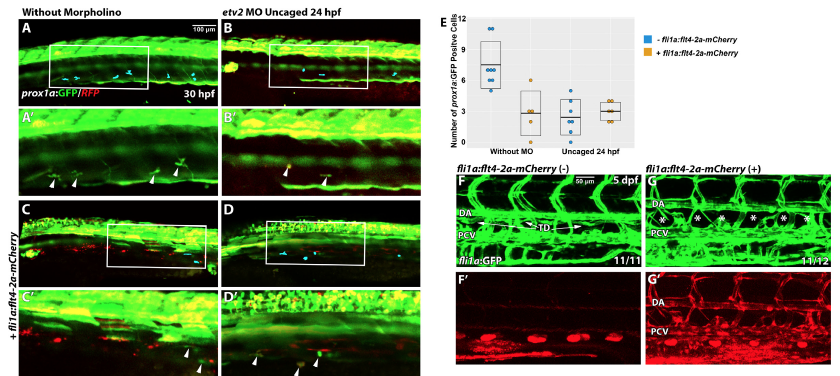Fig. S9
Vascular specific overexpression of Flt4 is not sufficient to rescue lymphangiogenesis defects in photoactivated etv2 knockdown embryos.
(A,B) The number of lymphatic prox1a:GFP cells is reduced at 30 hpf in embryos injected with etv2 Photomorph solution and photoactivated at 24 hpf (2.4±0.6, n=7) compared to control uninjected embryos (7.5±0.8, n=8, p<0.001, two-tailed Student’s test). Note that prox1a reporter expresses both RFP and GFP.
(C) Injection of fli1a:flt4-2a-mCherry results in a reduction of the number of prox1a:GFP+ cells at 30 hpf in wild type embryos (2.8±1.0, n=5, p=0.004).
(D) Co-injection of fli1a:flt4-2a-mCherry together with etv2 Photomorph solution followed by photoactivation at 24 hpf results in a reduced number of prox1a:GFP cells (3±0.4, n=6, p=0.48 compared with the injection of etv2 Photomorph alone, panel B). (A’,B’,C’,D’) are higher magnification images of (A,B,C,D).
(E) Quantification of prox1a:GFP cell number in the trunk region (across 9 somite length) in different groups. Each data point corresponds to the cell number in a single embryo. Mean±SEM values are shown. Arrowheads or blue pseudocolor indicate prox1a:GFP+ cells within the PCV.
(F,G) Stable transgenic fli1a:flt4-2a-mCherry larvae (G,G’) have defective thoracic duct development at 5 dpf compared to fli1a:GFP larvae (F,F’). Each experiment has been repeated a minimum of two times.
Reprinted from Developmental Biology, 440(1), Davis, J.A., Koenig, A.L., Lubert, A., Chestnut, B., Liu, F., Desai, S.P., Winkler, T., Pociute, K., Choi, K., Sumanas, S., ETS transcription factor Etsrp / Etv2 is required for lymphangiogenesis and directly regulates vegfr3 / flt4 expression, 40-52, Copyright (2018) with permission from Elsevier. Full text @ Dev. Biol.

